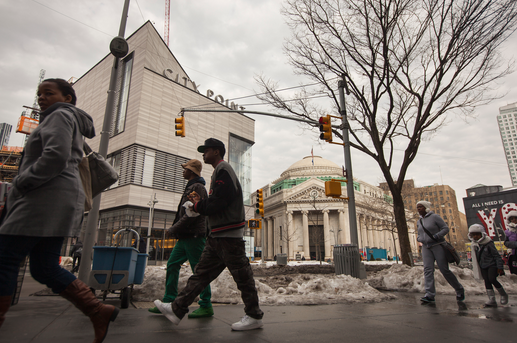Though controversy has surrounded the City Point development in Brooklyn since its inception, the development’s first residential tower is rising under the radar as the tussles subside, at least temporarily, and the commercial real estate industry readies for a major boost for the Downtown Brooklyn area.
The residential portion of the project’s second phase has risen roughly six stories thus far, and developers hope that as it rises it will cast a shadow on the spats that have driven the dialogue away from the development’s positive impact on the neighborhood.

“We are very excited, because this is going to bring a wide range of shopping and entertainment options for all of Brooklyn,” said Thomas Montvel-Cohen, a spokesperson for Acadia Realty Trust, which along with developer Washington Square Partners owns the ground lease on the property.
The developers have touted City Point, which broke ground in the summer of 2010, as the first new commercial building to hit Fulton Mall in 30 years. But by the time its first tenant, Armani Exchange, arrived in November 2012, local residents were waiting at its doorstep to protest the relatively high-end store and the government subsidies financing the project.
Fierce controversy ensued, from the heated exchange with Building & Construction Trades Council of New York President Gary Labarbera to spats over nonunion vs. union labor. But negative media coverage seemed to overshadow the optimism in the real estate community—and the community at large—regarding the project.
Encompassing up to 700,000 square feet of retail space and at least two residential towers, the massive 1.8-million-square-foot project reflects a need and desire for large-scale development in Brooklyn echoed by that rising nearby at Atlantic Yards.
“It’s the icing on the cake and the whole cake,” said Massey Knakal’s Stephen Palmese, who proclaimed that the project, while still in its infancy, has already transformed Brooklyn. “Without it, Brooklyn would feel a little bit empty and incomplete.”
Mr. Palmese said that asking prices for land in the immediate neighborhood—phase one is rising at 1 Dekalb Avenue—skyrocketed from roughly $75 per buildable square foot in 2011 to upward of $350 per foot today.
One half of the first residential tower’s 250 units will be designated affordable housing. The market-rate apartments, along with other residential developments nearby, are setting new standards for Downtown Brooklyn apartment pricing, with sources estimating rents in the $65- to $70-per-square-foot range.
“Downtown Brooklyn has entered a new era for residential development,” Mr. Palmese said. “This is going to add to and further solidify the critical mass required to give it the pulse of a 24/7 neighborhood.”
In addition to Armani Exchange, Century 21 and a seven-screen Alamo Drafthouse Cinema committed to the project, City Point last month landed artist management and creative content agency Art Partner, which signed a 15-year, 10,000-square-foot deal.
Names like Barneys, T.J. Maxx, Express, Gap, H&M and Aeropostale are among the retailers that have opened or are laying down roots in the vicinity, transforming a shopping destination that had been seemingly lost in time for decades.
“City Point is seeking to attract shoppers from all over the borough and Manhattan,” Mr. Montvel-Cohen said.
As for the controversy, the developers have actively defended their track record. When neighborhood residents and groups complained early on about the government subsidies given to the developers, Mr. Montvel-Cohen noted that the project benefits from a single government subsidy, essential for City Point’s affordable housing component. From Mr. LaBarbara’s thrashing of the developers in January 2013 for “failing” to meet the needs of the community to various disagreements over union vs. nonunion labor, the developers have stood firm.
So far, the project has achieved $35 million in minority contracting, and more than 70 percent of work was performed by local and minority workers, not to mention the project will result in 1,000 new permanent jobs for the borough, Mr. Montvel-Cohen said.
“We are very proud of our record of aggressive local and minority hiring,” he said.



